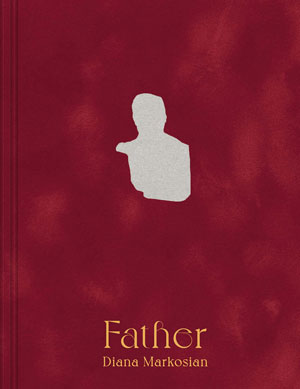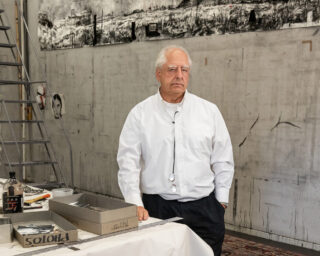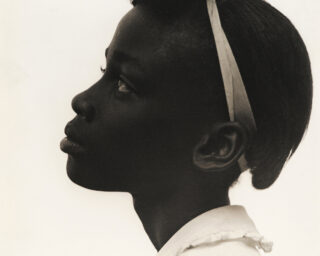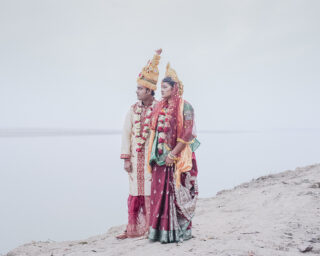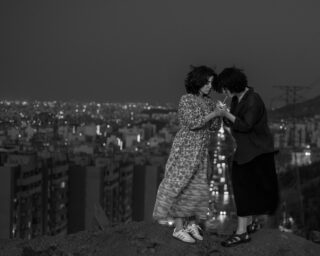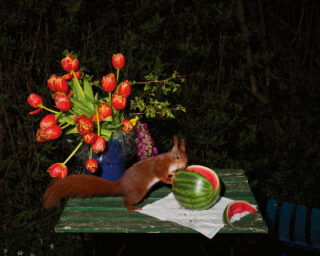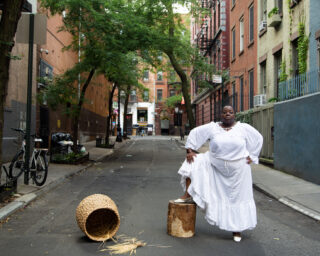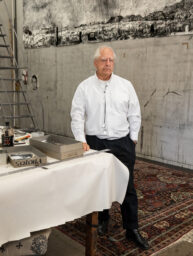Editor's Note
Editor's Note

Jane Mount, Ideal Bookshelf 1012: Daria Tuminas
A book with “cinematic flair”; “a quasicinematic, nonlinear narrative”; “raw, cinematic, stream-of-consciousness”—you hear these things about photobooks all the time. But what exactly is this cinematic aspect of these publications? And what is the relationship between cinema and the photobook at large?
The historical interconnection goes back to the very beginning of both mediums. As Olivier Lugon points out in Between Still and Moving Images (2012), “already, before the advent of the Lumière cinematograph, paper had been the privileged medium for cinematic movement, from the plates of the phenakistoscope and the zoetrope, to cards for Mutoscope machines, to the pages of flip-books.” The dynamic between the two forms has been explored for nearly a hundred years, from the work of avant-garde artists in the 1920s, to the phenomena of fotoromanzi and photonovels in the 1950s, to cinema theory in the 1970s, and beyond.
At the same time, classical cinema has been radically transformed due to technological change—such as the explosion of digital that resulted in interactivity and virtuality, starting in the 1980s and ’90s. Cinema as something that, in Chris Marker’s words (Immemory: A CD-ROM, 1997), is “bigger than we are, what you have to look up at,” has long vanished. We watch movies on our smartphones, turning cinema into a mobile, manipulable, and intimate matter. Add to that an everevolving number of possible presentation modes, from multiscreen installations to projection domes. With this new state (or should I say “states”?) of cinema in mind, it’s interesting to think about how photobooks have also changed in turn, and to question whether they have mirrored the processes taking place in cinema. David Bate, in Imprint: Visual Narratives in Books and Beyond (2013), claims that “many photobooks operate like silent movies, with a main title, introduction text, and short captions or ‘intertitles’ to signal the direction and flow of the ‘movie.’” While this silent-movie pattern is indeed recognizable in a number of publications, there is probably even more to the relationship between cinema and the photobook now, when physical books have started to cross-fertilize with the digital.
Both cinema and photobooks belong to the history of image seriality and ordering; they can also be analyzed alongside slide shows, photo-essays, and other kinds of sequences. As David Campany outlines in Photography and Cinema (2008), “Any orchestration of images is montage.” Do the principles of montage in all of these different types of assemblies—from the turn of a page, to the click of a slide—correlate? If so, how? Does the photobook borrow from cinematic montage techniques, or does it have its own specific ways of sequencing?
These core questions serve as a framework for inquiry, rather than an attempt at comprehensive answers, for this issue of The PhotoBook Review. They also serve as the impetus for inviting a host of curators, artists, and writers—all of whom have spent time thinking deeply about these matters— to participate. Additionally, I have proposed another angle for discussion in this issue, picking up on an approach introduced by the guest editor of the last issue, Denise Wolff. That issue focused on “accidental photobooks”—those publications that have not been “awarded the status of photobook proper.” Following Wolff’s “recipe,” I would like to open the floor to publications that normally exist in a world parallel to the classic photobook, and yet can address, in their own ways, similar themes: books made by video artists, artists’ books (works of art experimenting with the book form), and books made by film aficionados, experts, and scholars. At times, the photobook world can seem isolated, and the subject of the current issue gives us the opportunity to explore and intertwine with other types of visual publishing. We will see how the book form can play with the moving image, serve as an analytical tool to interpret cinema, or exist in tandem with a video. In addition to the artists and authors who have contributed to this issue, I would also like to express my gratitude to the Mondriaan Fund for their support of my research; to curator Zhenia Sveshinsky, who served as my partner during brainstorming sessions in the early stages of my research; to Johan Deumens, a passionate book lover and gallerist, through whom I was introduced to the wide world of artists’ books; to Hripsimé Visser, who—together with the museum’s public-program team—has shared my interest in the subject and generously supported my initiatives.
Jane Mount (illustration) makes things for people who love books. idealbookshelf.com
Image credit: Jane Mount, Ideal Bookshelf 1012: Daria Tuminas




